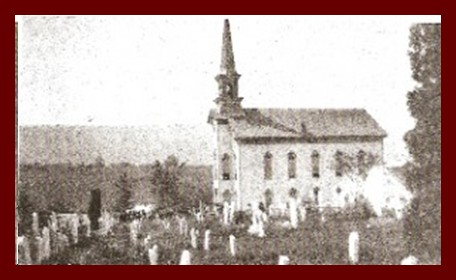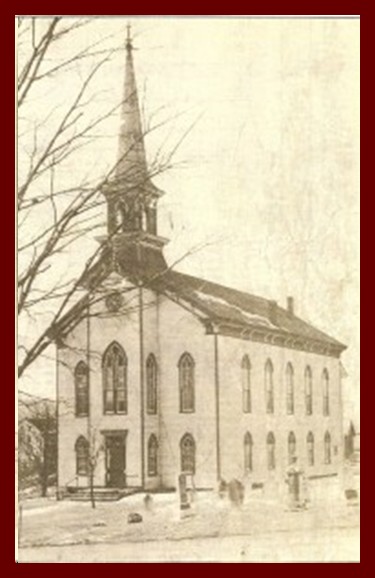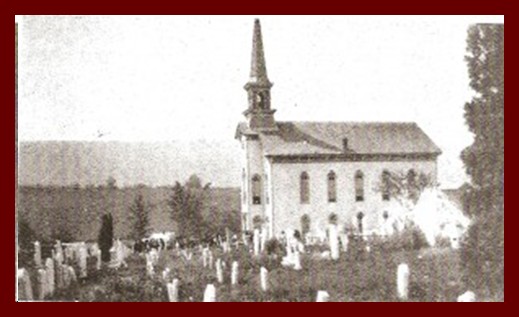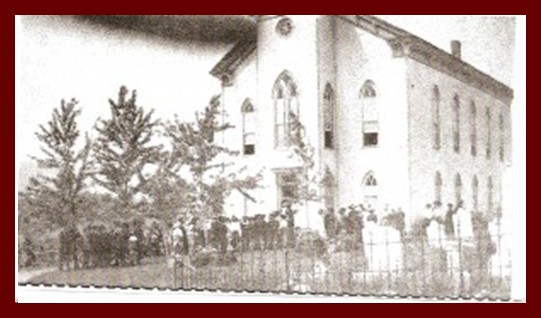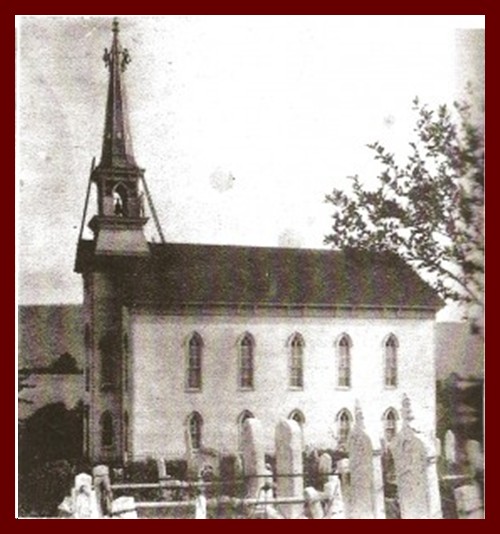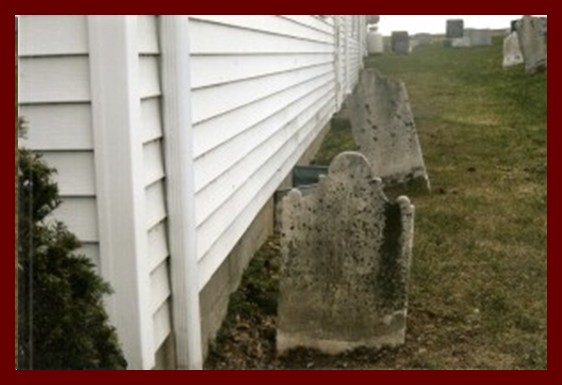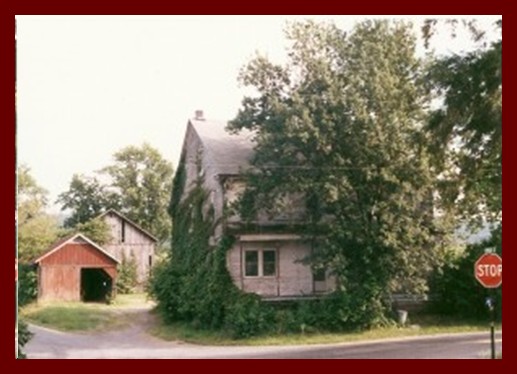The following was taken from a talk by Steve E. Troutman at the Gratz Historical Society meeting, October 28, 2010 held at the Simeon Lutheran Church in Gratz, Dauphin County, Pennsylvania.
___________________________________________________
Tonight I want to talk a bit about the area where I live near the Village of Rough and Ready in the Mahantongo Valley. In the past,. the waters of the Mahantongo Creek provided power for five grist mills and many generations of millers near Rough and Ready. The families that built and operated these five mills were all associated with the Salem Church. First I want to talk about the origins of the Salem Church.
I can see the Salem Church from my house. The building we see today is the third church at this location. The cornerstone of the present building was laid Sunday, June 9, 1895. The church is located on a hill in the middle of the valley, and is able to be seen at great distance. One record states that the Salem Church was organized in 1820, and its meetings were first held in an old schoolhouse near where the present church was built. No doubt this church and schoolhouse were one and the same log building, similar to the first church-school built in 1807 at Jacob’s Cemetery located at Line Mountain, Pennsylvania, where the St. Jacob’s (Howerter’s) Church was established in 1803.
Other accounts give much earlier dates for the establishment of an organized church for Salem’s location. The Northumberland County Historical Society Proceedings, Vol. XXX, 1990, page 47 records an interview with Myron Sausser of the Sausser Memorial business. He indicated that another earlier log church stood to the west of the present building. As a child he recalled coming to Salem with his father and grandfather to reset fallen stones of the cemetery. He remembered many stones being stacked in the basement of the church building that now stands and others stored in a caretaker’s shed that stood near the site of the first log church. Sausser remembered playing on the foundation of the log church and recalls it having a separate cemetery. He recalls his grandfather stating that the early cemetery at the site of the log church– now a plowed field – had more than 50 graves dating from the 1790s. In the present graveyard there are as few stones from the 1830s, fewer from the 1820s and none before 1810.
Mrs. Naomi Starr was interviewed by Rev. Eldon Ehrhart for the 150th Anniversary of Salem Church (1830-1980). Naomi tells us she remembers her grandfather speaking about another log church located east of the present structure, containing a balcony and a wine glass pulpit., This would be the second structure with a corner stone dated 1831.
The establishment of this church has an interesting story. Naturally the first necessity to build a church is to have some land. Jacob Whery and Peter Schlegel were appointed to secure some property. These trustees were successful and found some land available to purchase from Mr. George Simmy, a free black man of Upper Mahantongo Township, Schuylkill County, Pennsylvania. This deed, dated September 12, 1823, was for twp acres of land. George Henninger and Kathryn Henninger and Jacob Bechtel graciously purchased the land for the sum of $8 and donated it for the building of the new church. A building committee was appointed in 1829 and soon after that, (near the end of 1830) work began on the church building.
According to the oldest records of the Reformed Church, the Reformed congregation was organized in 1824 by Isaac Stiely, who was still a student. He was not ordained until 1827 and the building itself was erected in 1830. Pastor Stiely was paid $25 a year. By 1880 there were about 200 members.
_______________________________________________________
__
__
Pictures of the Salem Church taken in 1912. The iron fence is plainly visible in the one above.
__________________________________________________
Clervin Wehry and Edward Wehry are seen working on the steeple of Salem Church.
_____________________________________________________
Jacob Wehry monument is located at the northeast corner of the church social hall. 1775-1847, 71y 6m 21d.
_____________________________________________________
Jacob Wehry and Peter Schlegel were instrumental in purchasing land which the Salem Church is built upon.
Shadle’s General Store was last operated by Francis Shadle and was the focal point of the Village of Rough and Ready. The post office was located here, named for President Zachary Taylor.
Pastor Mark I. Rothermel serves Salem Church in Rough and Ready [2011]. The following is his history as recorded in Lifeline of the Line Mountain Charge, August 10, 2008, entitled “Brief History Lesson on the Origin of the Name Rough and Ready Church.”
One of Salem’s nicknames is the ‘Rough and Ready Church.’ It sounds intimidating at first, but it should not be so. The village and hence the church of Rough and Ready are named after the 12th U.S. President, Zachary Taylor. He was both a gentleman farmer and a general officer in the U .S. Army. He earned the nickname “Rough and Ready” from his soldiers while serving in the Seminole War in Florida. He got the name because he shared the hardships of the common soldier. General Taylor became a household name during the Mexican War by leading the U.S. Army to several victories in northern Mexico. In 1848 he was elected President of the U.S. as head of the Whig Party. He died in office in 1850. He served a mere sixteen months.
Zachary Taylor was a bit of a contradiction. He was a southern Slaveholder who opposed the extension of slavery. Even though a Southerner, he was a staunch union man and rejected any talk of secession. His early death was a severe blow to the nation, which lost a real leader who may have led it away from Civil War. The village and church can be proud to be called “Rough and Ready.”
____________________________________________________
July 2001. The Rough & Ready store was earlier known as Adam Herb’s store. This establishment sold everything the local people needed, including gasoline. The pumps were in front of the porch.
__________________________________________________
The following information is recorded in the 150th Anniversary Celebration of Salem Church by Rev. Eldon Ehrhart:
“In 1979, when we were making preliminary arrangements to borrow money for our church expansion project, we discovered that the only extant deed we had was dated April 22, 1854, between Peter Schlegel and George Simmey both of Upper Mahantongo Township in the County of Schuylkill, state of Pennsylvania of the first part and members of the Salem Church of the Lutheran and Presbyterian Congregations of the other part, for the sum of $10.50.”
George Simmey owned all the land where Clarence Wiest lived (now [2011] the residence of Brian Klinger and Sheila Klinger), up to and including where the church stands today. Simmey is the only black person ever buried at Salem Cemetery. He had two sisters and was the father of two boys.
_________________________________________________
Contributed by Steve E. Troutman. First published as a blog post on October 6, 2011, on “Mahantongo Heritage,” sponsored by PAHistorian.
Corrections and additional information should be added as comments to this post.
[African American]
